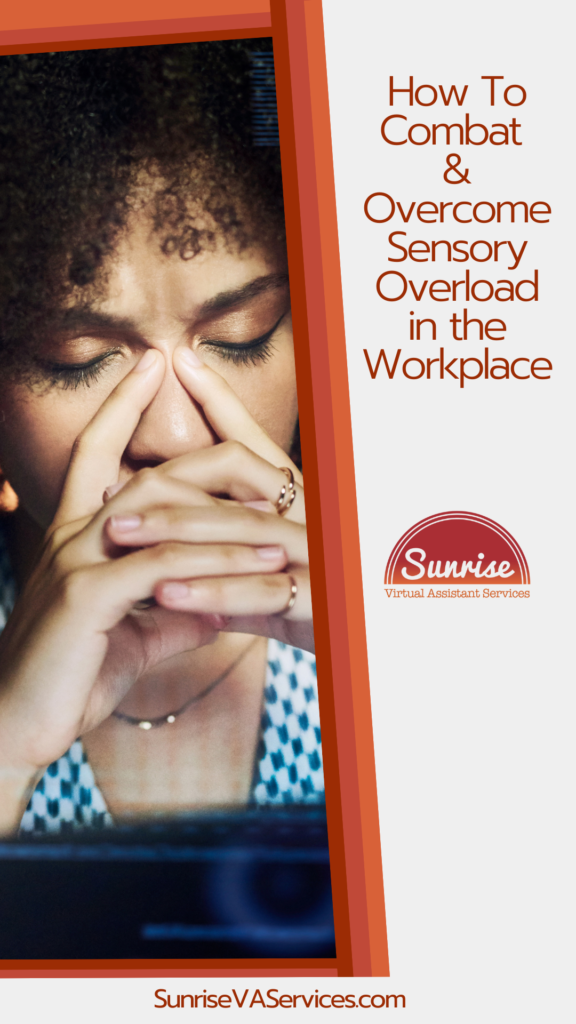Sensory overload in the workplace is a common yet often overlooked issue. Recognizing and addressing sensory overload is essential for maintaining a healthy and productive work environment.
In this blog post, we’ll discuss some practical strategies to combat and overcome sensory overload in the workplace.
Neurodivergent individuals, such as those with autism, ADHD, or SPD (Sensory Processing Disorder), may face additional challenges in the workplace due to their heightened sensitivity to sensory stimuli.
However, these strategies can benefit anyone by creating a more comfortable and manageable work environment. Let’s get started!
What is Sensory Overload?
Sensory overload can be likened to a computer receiving too many commands at once.
When a computer has multiple programs running, countless tabs open, and vast downloads happening all at the same time, it can become overloaded. The processing speed slows dramatically, the software may freeze, or, worse, the computer could crash.
Similarly, when our senses are bombarded with stimuli, our brain struggles to process all the information effectively, leading to feelings of overwhelm, anxiety, and reduced performance.
What is sensory overload like?
The sensation of sensory overload for a person is an overwhelming onslaught of sights, sounds, and sensations coming in all at once, making it exceedingly difficult to focus on any one thing.
It’s sort of like attempting to pick up a little bean from the ground while people are jumping and yelling around you, tossing balloons. You are constantly pushed and poked, and every so often, the bright lights flicker, all while you are striving to locate that one tiny bean (and avoiding being trampled by the jumping!). It’s a lot to manage!
For business professionals, this sensory overload experience could translate into struggling to concentrate during that important meeting because the buzzing lights are too loud or the smell of a coworker’s lunch is too pungent.
For those on the spectrum, this is an everyday reality. Sensory overload can be exacerbated by the regular hum and buzz of a busy workplace. The constant pings of email notifications, the chatter of coworkers, the glare of fluorescent lights, or even the texture of office attire can turn into sensory landmines.
For an autistic person for instance, it’s not just about being easily distracted – it’s about navigating an environment that can sometimes feel hostile due to sensory hyper-reactivity.
Symptoms of sensory overload
Sensory overload symptoms can manifest in different ways, and may vary from person to person. Some common signs of sensory overload include:
- Irritability
- Anxiety or panic attacks
- Difficulty concentrating
- Headaches or migraines
- Fatigue or exhaustion
- Avoidance of certain environments or stimuli
If you notice any of these symptoms in yourself or your colleagues, it may be time to address the issue around the office.
Causes of sensory overload in the workplace
Numerous factors can contribute to sensory overload in the workplace for both neurotypical and neurodivergent people. Some common causes for sensory processing difficulties include:
- Open office layouts: While an open office plan may promote collaboration and communication, they also create a high level of noise and distractions.
- Glaring or flickering lights: Bright artificial lighting or blinking fluorescent lights can be overwhelming for some individuals sensory systems.
- Strong smells: Not only is that one employee who insists on defiling the break room with scents of reheated seafood unpleasant, but it can also cause sensory overload for some individuals. Strong smells can be particularly challenging for those with hypersensitivity to scents.
- Loud or sudden noises: Constant noise from office equipment, conversations, and interruptions can cause sensory overload.
- Cluttered or visually busy workspaces: A cluttered desk or an overwhelming amount of visual stimuli on a computer screen can contribute to sensory overload.
- Uncomfortable clothing or temperature: Sensory overload can also be triggered by physical discomfort, such as restrictive clothing or extreme temperatures.
Sensory Overload in Neurodivergent Individuals
People with autism spectrum disorder (ASD), those with ADHD (attention-deficit hyperactivity disorder), or individuals with Sensory Processing Disorder (SPD) often experience heightened susceptibility to sensory issues.
For these neurodivergent individuals, the everyday work environment can pose unique challenges due to their increased sensitivity to sensory stimuli. However, it’s essential to remember that everyone’s sensory sensitivities are unique, and not all neurodivergent people will have the same sensory triggers or reactions to stimuli.
But here’s the good news: understanding and addressing sensory overload can immensely improve workplace comfort, focus, and productivity. The action plan itself should be about creating an environment where every human brain, neurodiverse or not, can thrive and perform to its full potential.
So, let’s dive a little deeper into what you can do to combat sensory overload in your workplace.
Strategies to combat workplace sensory overload
Being able to advocate for one’s needs in the workplace is crucial, especially when dealing with sensory overload.
Here are a few tips to help employees express their needs and request appropriate accommodations:
- Open dialogue with your manager: Employees should feel comfortable discussing their needs with their supervisor or manager. This could include explaining their sensitivity to certain stimuli and how it affects their ability to focus and be productive.
- Request for specific accommodations: If certain aids like noise-canceling headphones or having a quiet space for breaks can help, employees should not shy away from making these requests. It’s important to communicate how changes, like a quiet room away from loud noises, can improve their productivity and overall job satisfaction.
- Propose alternatives to traditional team meetings: If crowded and noisy meetings are overwhelming, employees can suggest options such as virtual meetings, smaller group sessions, or one-on-one meetings. This not only helps with sensory overload and stressful situations, but could also lead to more focused and productive discussions.
- Seek support from Human Resources: If discussions with a manager or supervisor aren’t fruitful, employees should feel free to reach out to Human Resources for help. They can assist with formalizing accommodation requests and reinforce the company’s commitment to a diverse and inclusive workplace.
Remember, the goal is to create a comfortable and productive work environment for everyone. By standing up for their needs, employees contribute to this goal and foster a more understanding and inclusive workplace culture.
Managers and CEOs can support neurodivergent employees by creating an inclusive environment with accommodations, making the company culture more hospitable and open to new ideas.
Conclusion
Sensory overload is a significant challenge faced by both neurotypical and neurodivergent individuals in the workplace. Understanding its triggers, symptoms, and repercussions is a critical first step toward creating a more inclusive and comforting work environment.
By encouraging open communication, advocating for personal needs, and implementing practical strategies, we can make the workplace a more productive and manageable space for everyone.


